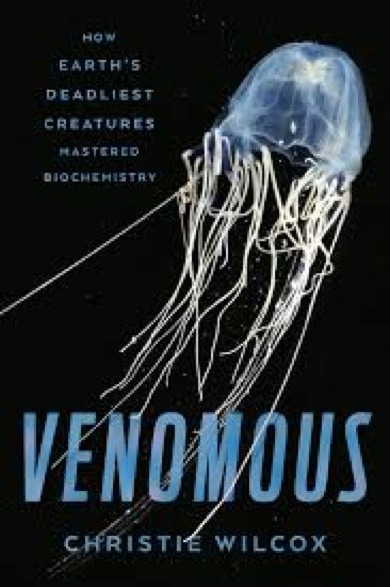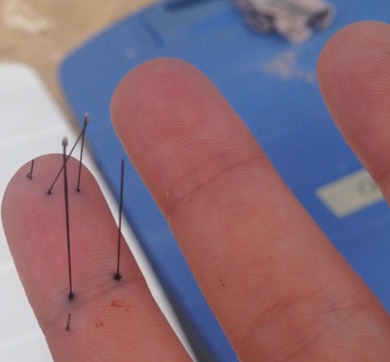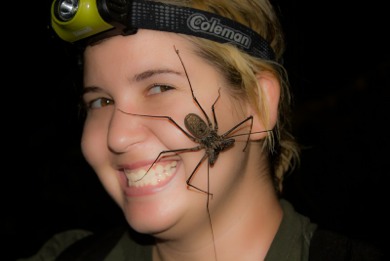If you’ve ever been stung by a jellyfish while swimming in the ocean, you know firsthand the pain that a venomous creature can inflict, even if it doesn’t outright kill you. But scientists studying the chemical properties of venom might one day be able to develop therapeutic drugs that could save lives.
Red lionfish, a.k.a. Pterois volitans, is just one example of venomous creatures in nature. (Image: Dennis Jacobsen/Shutterstock)]
That’s just one of many reasons that Hawaii-based marine biologist Christie Wilcox loves all these venomous little devils — so much so that she’s written an entire book about them, called Venomous: How Earth’s Deadliest Creatures Mastered Biochemistry. We chatted with Wilcox to learn more about these fascinating creatures, as well as why some people deliberately inject themselves with venom, and why you really shouldn’t pee on a jellyfish sting.
Gizmodo: We tend to use venom, poison, and toxin interchangeably in casual conversation, but they are actually quite distinct.
Christie Wilcox: Toxins are the big umbrella category. Something is a toxin if it causes harm to your body in small doses. Within that, there are various types of toxins, and we break those down by how they enter the body. Those that are ingested, absorbed, or inhaled are poisons. Those that are physically shoved through some type of wound via a bite or sting are the venoms.

A platypus “envenomating” a defenseless towel. (Image: Christie Wilcox)
I organised my book according to what the venom does. I didn’t want to follow the pattern of every other book on venomous animals, which either focus on [geographical] locations, or group them according to certain species. You have books on venomous snakes of the Southwest, for instance, or venomous animals of Australia. I wanted to show that venoms are surprisingly similar across these broad planes. You have platypus with toxins that are similar to snakes and spiders. Many times over, in evolution, we see the same families of proteins being recruited as venoms.
It really is astonishing that there are so many different kinds of venomous animals, as if nature evolved this over and over again in lots of different ways.
Wilcox: I think it speaks to how beneficial venom is as an adaptation. Adaptations that are very useful come up again and again. Flight evolved in a couple of different groups, because flight is pretty awesome. You can escape predators, explore new places, and travel longer distances, plus it’s pretty cool to be up in the air. Just about every branch on the tree on life has some venomous member, suggesting that it’s an extremely useful thing.
At the same time, it’s not something that is easily maintained. It’s what I call “energetically expensive.” [Studies show] a large increase in metabolism when species are trying to replenish their venoms — with snakes especially, because they are easy to milk and then we can measure their metabolism while they are replenishing the milk venom we just took from them. It’s the energetic equivalent of being pregnant. Replenishing your venom glands is equivalent to growing a tiny human, which is just mind blowing.
There are people who claim they can build up an immunity to venom by deliberately injecting themselves with small amounts, just like the so-called “poison king,” Mithridates. Is that really possible?
Wilcox: Some of that is real. A lot of these toxins are big proteins, and the fact that we can make anti-venoms suggest we can at least become temporarily immune to venoms. We are taking advantage of the animals’ immune system, injecting them with venom so they produce antibodies against those toxins. Then we inject those antibodies, loosely speaking, into a person.

That said, there are also toxins that slip right past our anti-venom producers, and there are certain toxins, like the potent paralytics, that are what scientists call “immunogenic” — they don’t stimulate the same immune response in animals. There are also site specific effects, like when a snake bites you and you have a [localised] tissue response very immediately. Even if you are injecting every day and have a high circulating amount of antibodies, it still would not get there in time to stop the damage. So I would say you can’t become completely immune to them.
What about that famous honey badger YouTube video showing the animal getting bitten by a cobra and still getting up and walking away after a short nap? The mongoose also eats venomous snakes and can withstand their bites. Can we learn anything from them about how to enhance our own immunity and ability to bounce back from a bite?
Wilcox: Yes and no. I wouldn’t technically say they are immune to venom; even they have a breaking point. It just takes a lot more of the stuff — for the mongoose it takes 1300 times the lethal dose for a rat, for instance. But studying their resistance can give us an insight into what mechanisms are most likely deadliest in the snake venom, and what counter mechanisms might work for us to reduce the damage from a snake bite. Some animals are innately resistant, meaning they have altered the chemical target of those toxins, namely, the ion channels and receptors. Something in their body at a fundamental molecular level is different, so the toxins just don’t work. That’s fascinating but doesn’t really benefit humans in terms of practical therapeutics, since we’re not sure yet how to change ours.
Then there are animals that have something in their blood — like opossums. They have special blood proteins that are essentially acting like constantly circulating antibodies, binding up all the toxins that enter the bloodstream before they have a chance to do much damage. There’s a limited number of these proteins, so again, if you inject enough venom you can knock them out. Scientists are currently looking at these chemical compounds to figure out if we can make versions safe for humans as an additive or alternative to anti-venom.
There’s a lot we can learn from studying venomous animals. People in the early 1920s were using cobra venom as a pain killer. Cobra venom has a lot of neurotoxins in it which block pain neurons just as effectively as they block muscle neurons. There are so many different chemicals that if you take out just one, it’s not necessarily going to have a negative effect on you. A paper came out recently showing how tarantula venom causes pain through this particular type of sodium channel, that we didn’t think had anything to do with pain. So now scientists have a new target and can design drugs to block those channels in certain chronic pain cases.
When you think about it, a pharmaceutical and a toxin are just two sides of the same coin. A pharmaceutical is something that causes our body to do exactly what we want it to do in a wall dose. A toxin is something that causes our body to do something bad in a small dose. So if you tweak the dose of the toxin, something that causes a [dangerous] drop in blood pressure goes from being a life-threatening condition to something that helps control hypertension. Paradoxically, these animals that can kill us might one day be the ones that save our lives.
You’ve been stung or bitten yourself several times over the course of your research.

Wilcox’s finger with venomous sea urchin spines. (Image: Christie Wilcox)
Wilcox: Yes. One time I was giving a group of second graders a tour of the tide pools, letting them collect a few cool animals and then telling them about them — like the mutually beneficial relationship between crabs and anemones. I made the mistake of grabbing a venomous sea urchin that found its way into the mix; most of them are non-venomous. I can tell the difference, but that day I was super stressed and wasn’t paying close attention, so I just reached in and grabbed it. Sea urchins have long spines as well as with shorter ones that are really venomous and brittle so they break off easily. I ended up with several spines in my finger. I was trying to be all tough about it: “I’m fine, I’m fine.” I was not fine. At some point I caved to the pain and left the beach.
Are there any immediate remedies that might work in such a case, like vinegar, or peeing on a jellyfish sting?
Wilcox: Vinegar is shockingly good for stings by marine animals like sea urchins or jellyfish. So is heat. I think it has to do with the fact that they live at such a cooler temperatures than we do and the venoms are meant to work at sea water temperatures. So when you heat them up to just a hair under scalding, as hot as you can stand, almost all marine venoms stop working. So for fish stings, I’d recommend hot water immersion.
As for jellyfish stings — no, don’t pee on it. Every time I have a new student or intern and need them to touch a jellyfish, I ask what they think they should do, and invariably they think they should pee on it because of the ammonia or something. I’m pretty sure it’s because of that Friends episode where Monica gets stung and Joey pees on her. It’s just a terrible idea for many reasons. Not least of which is you are getting peed on.

Image: Aaron Pomerantz
Your book has an entire section about people who have tried to commit murder with venomous animals, like that famous Sherlock Homes story, “The Adventure of the Speckled Band.” Which venom would you choose to commit the perfect murder?
Wilcox: I guess it would be based on where I was, because the perfect murder would have to look like it was hypothetically possible without me. I wouldn’t bring an Indian cobra to the middle of Louisiana and try to kill someone that way. It would have be something that looks like a natural sting or bite scenario. I would probably choose an elapid snake — in the U.S., that would be a coral snake, in Africa maybe a mamba or cobra. You’d have to be careful n Australia, though, because a lot of really venomous snakes there are shy and very rare. If you’re in the center of Brisbane and you get bit by an inland taipan, somebody is going to start asking questions.
You’ve clearly given this some thought.
Wilcox: No, of course not. (laughs)
I’m just saying that writing a murder mystery could be in your future.
